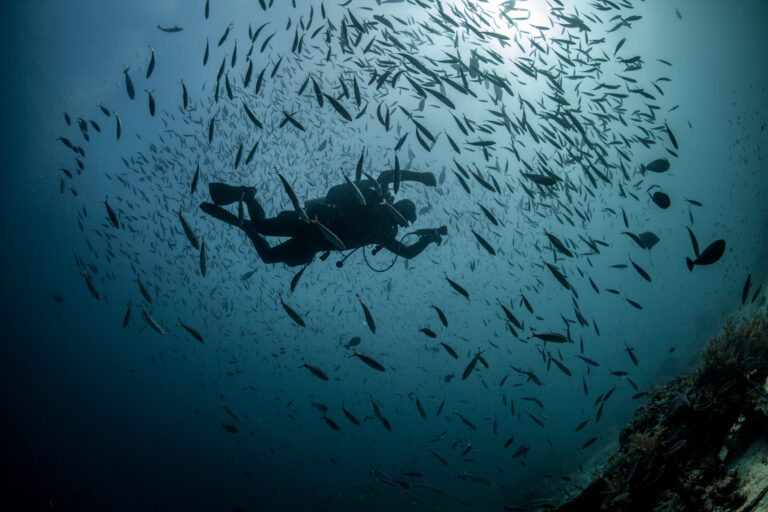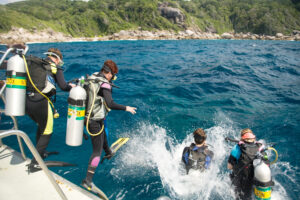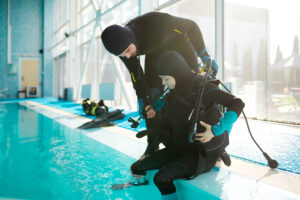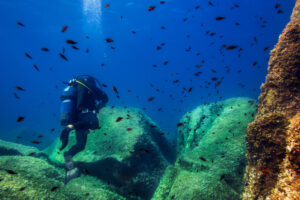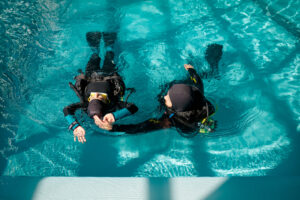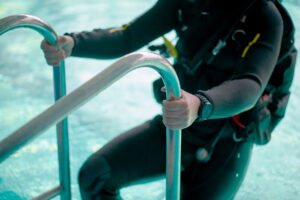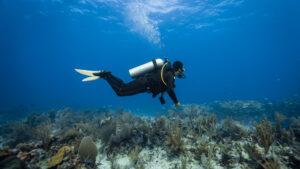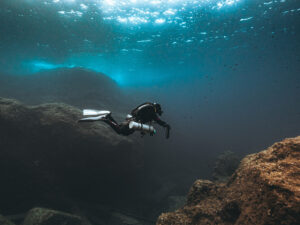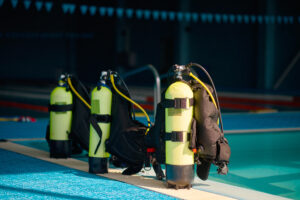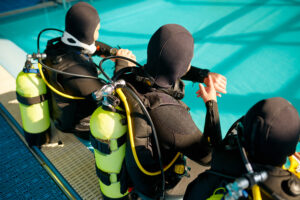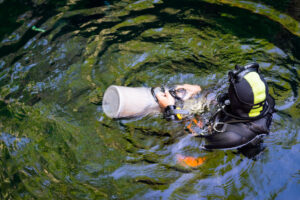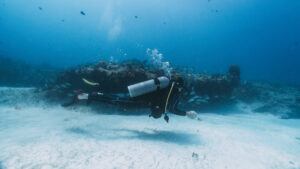What is a Lifeline?
A lifeline in scuba diving is a critical safety device designed to ensure the diver’s connection to a secure point, whether it be a boat, surface support, or another diver. This tether provides a physical or electronic means of communication and safety, offering reassurance and vital linkage in underwater environments. Given the potential dangers inherent in scuba diving, such as strong currents, poor visibility, and equipment failure, lifelines serve as essential tools for maintaining diver safety and facilitating effective rescue operations if needed.
Historical Development of Lifelines
The use of lifelines in diving has a rich history, dating back to the early days of underwater exploration. Initially, lifelines were simple ropes used by surface-supplied divers who relied on them not only for safety but also for communication through a series of pre-agreed tugs. These early lifelines were rudimentary, often made from natural fibers that were prone to wear and tear, but they laid the groundwork for modern diving safety protocols.
As diving technology progressed, so did the materials and designs of lifelines. The introduction of synthetic fibers in the mid-20th century marked a significant improvement. These new materials, such as nylon and polypropylene, provided greater strength, durability, and resistance to the harsh marine environment. Additionally, the development of more sophisticated diving suits and helmets, which included integrated lifeline attachment points, further enhanced diver safety.
Regulatory bodies and diving organizations have played a crucial role in the evolution of lifelines. For instance, the establishment of safety standards and protocols by agencies like the Professional Association of Diving Instructors (PADI) and the National Association of Underwater Instructors (NAUI) have driven advancements in lifeline technology and usage. These organizations have emphasized the importance of lifelines in training programs, ensuring that divers are well-versed in their use and maintenance.
Throughout the decades, the integration of lifelines into diving practices has significantly reduced the incidence of accidents and fatalities. Historical milestones, such as the widespread adoption of the buddy system and the development of underwater communication devices, have reinforced the lifeline’s role in promoting safety. As diving continues to grow as both a recreational activity and a professional endeavor, the historical evolution of lifelines underscores their enduring importance in safeguarding divers.
Types of Lifelines
Lifelines in scuba diving can be broadly categorized into physical and electronic types, each serving distinct purposes and offering various advantages depending on the diving scenario. Physical lifelines include surface-supplied lifelines and buddy lines, while electronic lifelines encompass advanced tracking and communication devices.
Physical lifelines, such as surface-supplied lifelines, are traditional tethers that connect a diver directly to the surface or a diving bell. These lines are typically made from robust, buoyant materials that ensure they remain afloat, reducing the risk of entanglement. Surface-supplied lifelines are particularly crucial in commercial diving operations, where divers may need to navigate complex underwater structures or perform tasks in low-visibility conditions. The constant connection to the surface allows for immediate communication and emergency response if necessary.
Buddy lines are another type of physical lifeline, used to connect two divers to each other. These lines are often employed in situations where divers must stay close together, such as in strong currents or poor visibility. Buddy lines help prevent divers from becoming separated, facilitating coordinated movements and mutual assistance. The length and material of buddy lines vary, but they are typically lightweight and easy to manage underwater.
Electronic lifelines represent a more modern approach to diver safety, utilizing technology to enhance communication and tracking capabilities. These devices include underwater communication systems, which allow divers to talk to each other or surface support through wireless or hardwired connections. Such systems can be crucial in complex diving operations where verbal coordination is necessary.
Advanced tracking devices also fall under the category of electronic lifelines. These gadgets use GPS or other positioning technologies to monitor a diver’s location in real-time. Surface support teams can track multiple divers simultaneously, ensuring that they remain within safe boundaries and can be quickly located in an emergency. The integration of electronic lifelines into diving practices has significantly improved safety outcomes, providing a reliable backup to traditional physical lifelines.
Components of a Lifeline System
A comprehensive lifeline system in scuba diving comprises several key components, each contributing to the overall safety and functionality of the setup. The primary elements include the rope or cord, connectors and harnesses, and maintenance and inspection protocols.
The rope or cord is the central component of a physical lifeline. It is typically made from high-strength synthetic materials like nylon, polyester, or polypropylene, chosen for their durability, buoyancy, and resistance to abrasion and UV damage. The rope must be capable of withstanding the stresses of underwater use, including constant exposure to saltwater and potential contact with sharp objects or rough surfaces. The diameter and length of the rope vary depending on the diving conditions and the specific needs of the divers.
Connectors and harnesses are crucial for securing the lifeline to the diver and the attachment points. Carabiners, snap hooks, and other quick-release connectors are commonly used to attach the lifeline to a diver’s harness or buoyancy control device (BCD). These connectors must be robust, corrosion-resistant, and easy to operate, even with gloved hands. The harness or BCD itself should have reinforced attachment points designed to distribute the load evenly and prevent accidental disconnections.
Regular maintenance and inspection of lifeline systems are vital to ensure their reliability and safety. Divers must routinely check the condition of the rope or cord for signs of wear, fraying, or damage. Connectors should be inspected for corrosion, proper functioning, and secure attachment. Any components that show signs of deterioration must be replaced immediately to prevent potential failures during a dive. Proper storage of the lifeline system, away from direct sunlight and extreme temperatures, also helps extend its lifespan.
In addition to the physical components, training and familiarity with the lifeline system are essential. Divers should practice deploying, managing, and stowing their lifelines under various conditions to ensure they can operate them effectively in real-world scenarios. Understanding the specific features and limitations of their equipment allows divers to make informed decisions and respond swiftly in emergencies.
Operational Procedures
Effective operational procedures for lifelines in scuba diving are crucial for ensuring diver safety and facilitating successful underwater operations. Proper deployment, handling techniques, and emergency procedures are integral aspects of these procedures.
Proper deployment of lifelines depends on the diving scenario and the type of lifeline being used. For surface-supplied lifelines, the rope must be carefully unwound and securely attached to the diver’s harness before descent. It is essential to maintain a manageable slack in the line to avoid entanglement while ensuring the diver can move freely. Surface support personnel should monitor the line continuously, ready to assist or retrieve the diver if necessary.
Handling techniques for lifelines involve maintaining tension and avoiding entanglements. Divers should keep the line taut enough to feel any tugs or signals from the surface or their buddy but not so tight that it restricts movement. In areas with potential obstacles, such as reefs or wrecks, divers must navigate carefully to prevent the line from snagging. Regular communication through line signals or electronic devices helps coordinate movements and ensure that both the diver and surface support remain aware of each other’s status.
Emergency procedures involving lifelines are critical for addressing potential issues that may arise during a dive. If a diver becomes entangled, they should signal their buddy or surface support immediately. In some cases, a quick-release connector may be used to detach from the lifeline temporarily to resolve the entanglement. Surface support should be prepared to assist in such situations, maintaining a clear line of communication and readiness to retrieve the diver if necessary. Training in these emergency procedures ensures that divers can respond swiftly and effectively to unforeseen challenges.
Another essential aspect of operational procedures is post-dive management of the lifeline system. After the dive, the lifeline should be carefully inspected for any signs of wear or damage incurred during the dive. The rope should be cleaned and dried to prevent salt and debris buildup, and connectors should be checked for proper functioning. Proper storage of the lifeline, coiled neatly and kept in a dry, cool place, helps maintain its condition for future use.
Role of Lifelines in Diver Safety
Lifelines play a pivotal role in enhancing diver safety by providing a reliable means of connection and communication. They significantly contribute to reducing accidents and fatalities in various diving scenarios, offering both physical and psychological reassurance to divers.
Statistically, the implementation of lifelines has led to marked improvements in diving safety. Divers equipped with lifelines are less likely to become lost or disoriented, particularly in challenging environments such as strong currents or low visibility. Lifelines enable surface support teams to monitor diver locations continuously, facilitating timely interventions if a diver strays from the planned route or encounters difficulties.
Practical examples underscore the effectiveness of lifelines in preventing accidents. For instance, in commercial diving operations, where divers often work in hazardous conditions, the use of surface-supplied lifelines ensures constant communication and support from the surface team. This setup allows for immediate responses to equipment malfunctions or health issues, significantly enhancing the diver’s safety.
Similarly, in recreational diving, buddy lines help maintain close proximity between dive partners, ensuring that they can assist each other promptly if needed. In scenarios where visibility is compromised, such as night dives or murky waters, buddy lines prevent divers from becoming separated, reducing the risk of panic and disorientation.
The psychological impact of using lifelines should not be underestimated. Knowing that they are connected to a secure point or their dive buddy provides divers with a sense of security, allowing them to focus more on the dive itself and less on potential dangers. This confidence can lead to a more relaxed and enjoyable diving experience, further emphasizing the value of lifelines.
The integration of electronic lifelines, such as underwater communication systems and tracking devices, has further elevated diver safety. These technologies enable real-time communication and precise location tracking, ensuring that divers can receive immediate assistance if needed. The combination of physical and electronic lifelines represents a comprehensive approach to safety, addressing both traditional and modern challenges in scuba diving.
Challenges and Limitations
While lifelines are indispensable tools for diver safety, they are not without their challenges and limitations. Understanding these limitations is crucial for divers and surface support teams to mitigate risks and ensure effective use.
One significant challenge is the physical limitation of lifelines, particularly in terms of depth and underwater obstacles. Surface-supplied lifelines can become cumbersome in deep dives, as the length of the rope increases the potential for entanglement and drag. In underwater environments with numerous obstacles, such as kelp forests or wreck sites, lifelines can easily snag, posing a hazard to the diver. Divers must be trained to navigate these environments carefully and manage their lifelines effectively to avoid entanglements.
Reliability issues also pose a potential limitation for lifelines. Despite being made from high-strength materials, ropes and connectors can still fail due to wear and tear, improper maintenance, or unexpected underwater hazards. Regular inspection and maintenance are essential to ensure that lifeline systems remain in optimal condition. However, even with proper care, unforeseen failures can occur, necessitating backup plans and additional safety measures.
The psychological impact of using lifelines can vary among divers. While many find the connection reassuring, others may feel restricted or constrained by the presence of a tether. This perception can affect a diver’s comfort and confidence, potentially leading to stress or reduced focus. Training and familiarization with lifeline systems can help alleviate these concerns, ensuring that divers feel comfortable and competent in their use.
Environmental factors also influence the effectiveness of lifelines. Strong currents, poor visibility, and extreme weather conditions can challenge the deployment and management of lifelines. In such conditions, divers and surface support teams must adapt their strategies to maintain safety. For example, in strong currents, divers may need to adjust their positions to minimize drag on the lifeline, while surface support may need to increase monitoring efforts to account for the dynamic environment.
Key Takeaways
Lifelines are essential safety tools in scuba diving, providing vital connections between divers and surface support or their dive buddies. Their historical development, types, components, and operational procedures underscore their importance in enhancing diver safety. While they present certain challenges and limitations, proper training, maintenance, and usage can significantly mitigate these issues. Understanding and effectively using lifelines can lead to safer and more enjoyable diving experiences.

